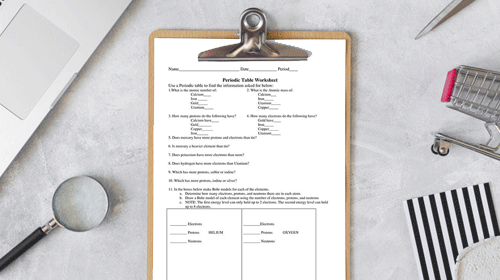A periodic table is a table arranging chemical elements according to the order of atomic number to help viewers learn about elements and solve chemistry problems. Nonetheless, the table arranges the data in rows, such that elements with identical atomic structures(and hence identical chemical characteristics) appear within the vertical columns.
Nonetheless, the standard periodic table entails all the 118 elements recognized by the International Union of Pure and Applied Chemistry(IUPAC).
Periodic Table Examples & Templates
Periodic tables can assist us in learning about elements and solving chemistry problems. Here are some examples and templates of various periodic tables available.
Identifying Unknown Elements

Introduction to the Periodic Table

Living Periodic Table Worksheet

Periodic Table Coloring Worksheet
Periodic Table Coloring Worksheet–explains the colors used to denote the chemical elements in question.

Elements of a Periodic Table
As said above, a periodic table is a table that presents all the 118 known chemical elements on earth, assorting them in the order of increasing atomic number.
Periodic Table Questions Sheet

Periodic Table Trends Worksheet
Periodic Table Trends Worksheet–explains the trends for the chemical elements shown within the periodic table. These specific patterns illustrate various aspects of a certain element, including its electronic properties and size. Examples of such trends include atomic radius, electronegativity, electron affinity, ionization energy, metallic character, and melting point.

Periodic Table Worksheet

Periodic Table of the Elements
Periodic Table of the Elements– a table arranging chemical elements according to atomic numbers to assist viewers in learning about elements and solving chemistry problems.

How do periodic tables work?
Periodic tables help us learn about chemical elements by arranging all the 118 known chemical elements on earth according to the order of atomic numbers. These tables group the elements with similar atomic structure and chemical properties together within vertical columns.
How can one memorize the periodic table?
An easy way to memorize the periodic table is to study your table every day.
How do you explain periodic tables to a child?
The periodic table can seem a little bit technical for kids to understand, but with the right strategy, you can explain and help your kid understand the table. An excellent way to do that is to use a suitable app. There plenty of such educational apps on Playstore, Appstore, and so on.
How to Use a Periodic Table of Elements
It is important to note that periodic tables are split into cells with each cell representing an element. Columns and rows are known as “Groups” and “Periods”, respectively. Nevertheless, elements with identical chemical characteristics are assigned a group name and, sometimes, given the same color. Additionally, there are four blocks, each containing different groups;
S-block – entails helium, hydrogen, alkali metals, and alkaline earth metals.
P-block – consists of groups 13-18.
D-block – made up of groups 3-12.
F-block – normally placed below the table, this block presents the lanthanides and actinides series of metallic elements.
Cells – these important components of a periodic table can entail various pieces of information, including the element’s atomic number and the one or two-letter atomic symbol, representing the element’s Latin name e.g “No” for “Nobelium.” Other information may include:
- Name- the full name of the element.
- Atomic mass- a decimal number directly below the symbol.
- Ionization number- indicates the amount of energy required to remove an electron from the element. It’s represented by a decimal number below the cell.
- Electron sequence- numbers are indicating the electron distribution within the element.
Other Information
- Color- various colors denote related groups of elements.
- Information box- expounds further on the various chemical terms used in the periodic table.
- Cell key- offers labels describing what each item means.
Looking For Document Management System ?
Call Pursho @ 0731-6725516
Telegram Group One Must Follow :
For Startups: https://t.me/daily_business_reads




